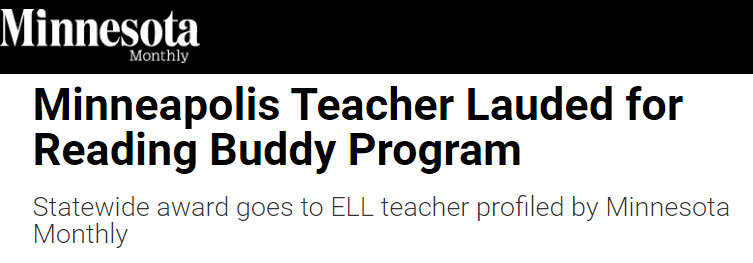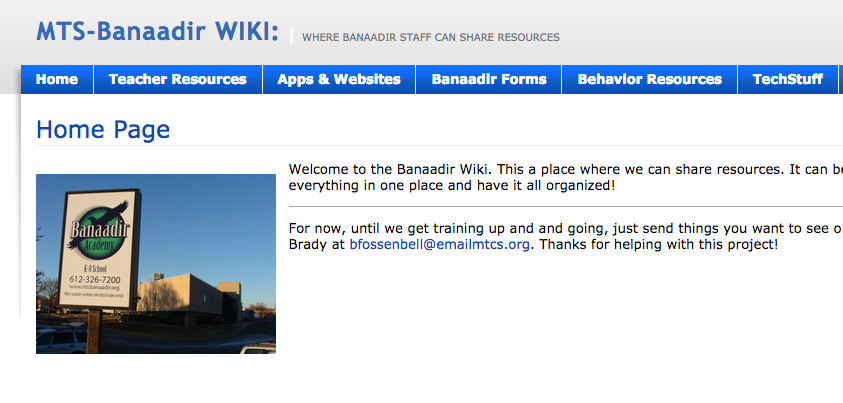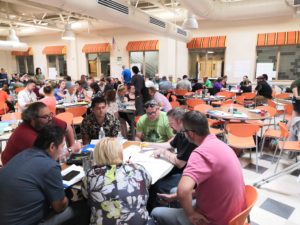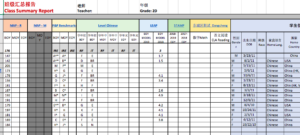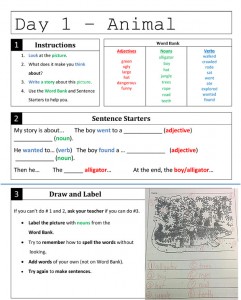Check out these new resources for practicing reading skills. http://www.cnn.com/studentnews/ CNN’s Student News site, with U.S. and International options, with simplified articles, podcasts, worksheets &
HTML-CSS
 Although I’ve been in education for over decade, I’ve kept my web skills sharp by developing sites at three districts that promoted department communication and resource development. These sites display my ability to use the industry-standard HTML frameworks WordPress and SharePoint, in addition to Adobe Creative Suite, HMTL and CSS in a variety of settings.
Although I’ve been in education for over decade, I’ve kept my web skills sharp by developing sites at three districts that promoted department communication and resource development. These sites display my ability to use the industry-standard HTML frameworks WordPress and SharePoint, in addition to Adobe Creative Suite, HMTL and CSS in a variety of settings.
Bilingual TLI Intranet Site
Through performing a needs analysis of departmental processes, the executive director of Teaching Learning and Innovation (TLI) and I collaborated on constructing a bilingual intranet site for the entire TLI department at Daystar. The scale of this site is quite a bit more extensive than previous sites I’ve built, as it supported all teachers in three schools and in two languages. With such varied needs, we had to devise differing levels of access for such documents as Individualized Support Plans (ISPs) and student assessment data. We did so using the Office Sharepoint platform, and the resulting TLI intranet site has become the one-stop shop in our district for student data, curriculum resources, assessment resources, policies and internal documentation for students with special needs and language learners. Teachers have told us it saves them a lot of time and that they also feel more supported with the resources made easily available to them.
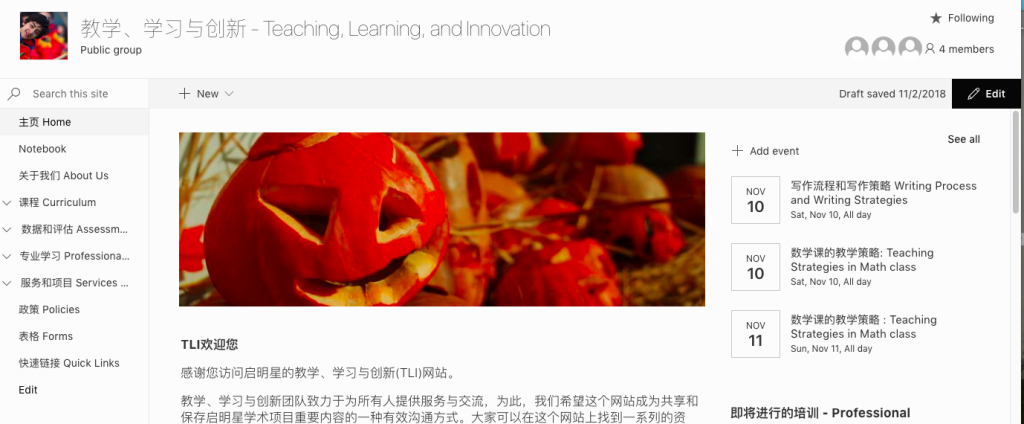
Academic Proficiency (LEAP) Team Intranet Site
Adams 14 CLDE Department Site
In the day-to-day world of teaching, there’s hardly time to use the restroom, let alone keep up with the myriad of emails, messages, and requests that teachers receive. This consideration is what prompted me to create the Learning English for Academic Proficiency (LEAP) Team Intranet Site for my team at Daystar Academy and the Adams 14 CLDE Department Site. They became the one centralized place where team members from three schools can access all of our in-house language support resources, WIDA resources, log-ins, weekly and monthly goals, and more. It houses our internal processes, such as new student checklists, as well as student data and a monthly to-do page with hyperlinked action items. The site has saved everyone time by reducing the number of emails I have to write and that my team members have to sift through when looking for materials or information. Furthermore, by granting the whole team permission to add files, I encouraged them to contribute and collaborate as well. For example, they have created a shared resource library and built a teaching sample video library so that all members can watch each other teach and reflect upon instructional practices across different campuses.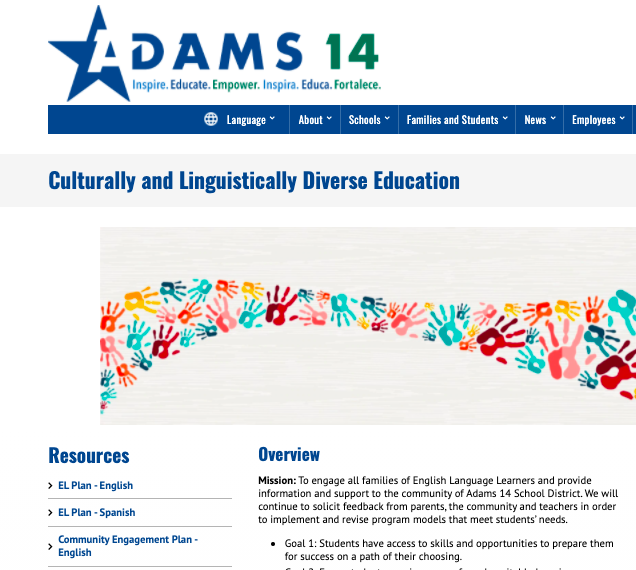
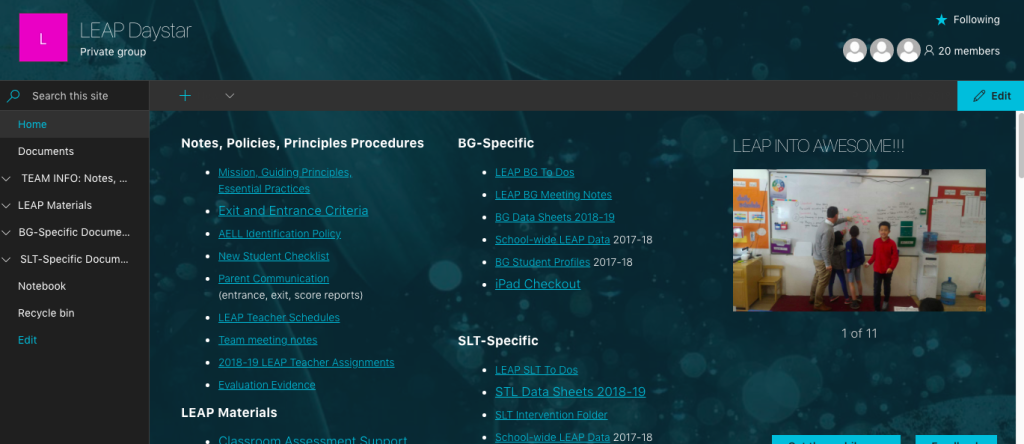
Banaadir Academy Resource WIKI
In 2011, Banaadir Academy (Minneapolis) was a new charter school just getting off the ground. As is often the case, it was full of talented, passionate teachers coming with great ideas and a slew of useful resources. In fact, so many good materials were being shared back and forth that teachers were overwhelmed and, as a result, didn’t use them. There was also no clear place to find things like time off requests and incident reports. Identifying this need, I worked with the principal to develop the Banaadir Resource WIKI. Teachers were able to share apps and websites, supplementary resources and behavior notes with each other in one place. Admin was also able to post relevant forms and tech support documentation. The site grew as teachers used it and it became and remained one of the primary communication tools for the school.
Design and Usability
In my previous career in commercial web development, I built front-end processes for successful large-scale e-commerce sites using Adobe Creative Suite, web analytics, and usability data for 10 years. The process of engaging in usability testing paired with analytic data and my educational acumen, has given me a unique perspective on user/learner experience in an online environment. The following displays these elements conveyed in design and user interaction.
User Interface Design
 |
 |
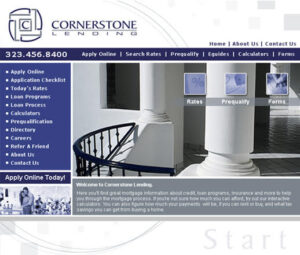 |
 |
 |
 |
ACADEMIC LANGUAGE PROFESSIONAL DEVELOPMENT FOR ADAMS 14- Remote Learning
During school closure during the pandemic, we needed to shift our professional development needed to shift format. In order for teachers to make the most of their time, we developed a series of e-workshops that could be undertaken asynchronously when time was available. We also used strong and weak examples that teachers analyzed and modeled our resources via Google
Classroom. We got great feedback from the teachers on the format and content.
Guidance During Remote Learning:
|
|
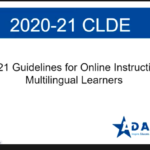 |
| Identification and Placement of Multilingual Learners |
|
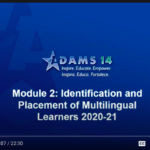 |
|
Norming Student Writing and Setting Goals |
|
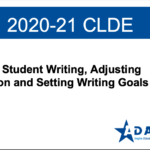 |
Including Language Information in IEPs
|
Module 1: Introduction to WIDA
|
Module 2: Present Levels
|
Module 3: Special Considerations
|
Tech Skills
In my previous career in commercial web development, I built front-end processes for successful large-scale e-commerce sites using Adobe Creative Suite, HTML, CSS, web analytics, and usability data for ten years. This foundation enabled me to go on to co-develop educational resource intranet sites for three different educational entities (MTCS, Daystar Academy and Adams 14 District), and to flourish in multiple learning management systems, including Black Board and Google Classroom.
Tech Skills
- Learning Management Systems (LMS)
- CSS / HTML
- Graphic Design
- Adobe Creative Suite
- Web Analytics | User Experience
- Google Suite | Microsoft Office
Professional Development and Planning Support for Teachers
ACADEMIC LANGUAGE PROFESSIONAL DEVELOPMENT FOR ADAMS 14- Remote Learning
During school closure during the pandemic, we needed to shift our professional
development needed to shift format. In order for teachers to make the most of their time, we developed a series of e-workshops that could be undertaken asynchronously when time was available. We also used strong and weak examples that teachers analyzed and modeled our resources via Google
Classroom. We got great feedback from the teachers on the format and content.
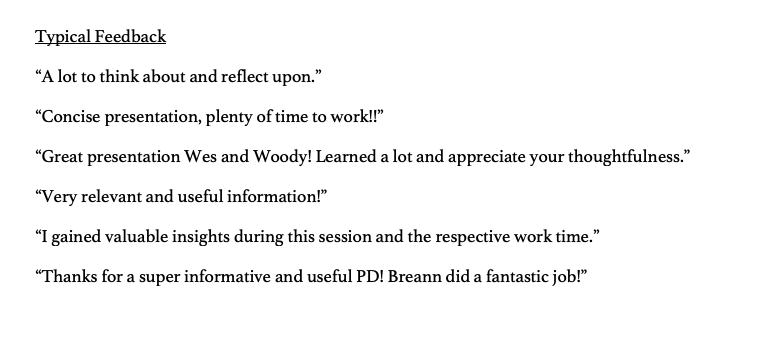
Guidance During Remote Learning:
|
|
 |
| Identification and Placement of Multilingual Learners |
|
 |
|
Norming Student Writing and Setting Goals |
|
 |
Including Language Information in IEPs
|
Module 1: Introduction to WIDA
|
Module 2: Present Levels
|
Module 3: Special Considerations
|
| Considering WIDA Levels | |
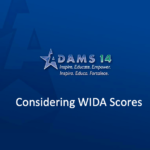 |
Examples of Model Student Responses with Sentence Frames
ACADEMIC LANGUAGE PROFESSIONAL DEVELOPMENT FOR ADAMS 14
As the K-12 Linguistically and Culturally Diverse Education Coordinator for Adams 14, I led the district-wide ELD-focused professional development, which led to an almost 40% increase in structured talk and decrease in teacher talk, and an increase in writing scores. We performed a needs analysis to determine our focus, assembled and cross-section of materials, trained teacher leaders on the material so they could lead the work with small groups. The sessions 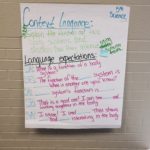 included relevant professional reading, modeling and sharing of strategies, use of student data, teacher planning time and always ended with a useable product (lesson plan, specific strategy or scaffold). Teacher feedback for the series was overwhelmingly positive in that teachers stated they were better prepared to support multilingual learners (MLs).
included relevant professional reading, modeling and sharing of strategies, use of student data, teacher planning time and always ended with a useable product (lesson plan, specific strategy or scaffold). Teacher feedback for the series was overwhelmingly positive in that teachers stated they were better prepared to support multilingual learners (MLs).
- Using WIDA, Sys ELD and CM to Increase Structured Student Talk OVERVIEW
- Using WIDA, Sys ELD and CM to Increase Structured Student Talk – Materials
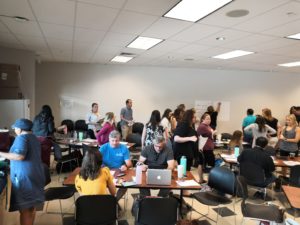 PLANNING FOR LANGUAGE PROFESSIONAL DEVELOPMENT FOR ADAMS 14
PLANNING FOR LANGUAGE PROFESSIONAL DEVELOPMENT FOR ADAMS 14
As the needs analysis from the district identified unit-level planning for language to a be a high need for teachers, our team developed district-wide ELD guidance and supports embedded into curriculum mapping and PLC processes based on WIDA Can Do Key Uses and the Forms and Function work of Susannah Dutro.
Beginning with the end in mind, our ELD teams use the WIDA Standards Framework to analyze academic unit and lesson content in terms of accessibility (comprehensible input) and expectations of students’ oral and written production. We then create language objectives and select appropriate material and implement supports and that align with learning targets WIDA level.
I have worked with teams in various district settings to create model student responses on formative assessments. Using guiding questions from WIDA and Constructing Meaning, we analyze our models for language patterns at the word/phrase, sentence, and discourse level. We then prioritize these language forms and chunk their instruction through the unit supported by word banks and differentiated sentence frames.
This resulted in increased teacher confidence and increased in writing scores.
- ELD Backwards Planning Support
- ELD Task Analysis- Example
- Primary Unit Level Language Planning
- Secondary Unit Level Language Planning
Examples of Model Student Responses with Sentence Frames
WIDA CLIMBS TRAINER
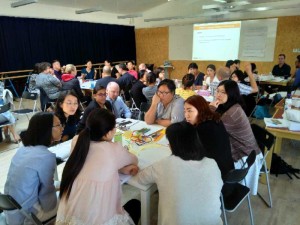 As a firm believer in WIDA and its Can Do Philosophy, I am excited to be an authorized WIDA CLIMBS Trainer (Content and Language Integration as a Means of Bridging Success).
As a firm believer in WIDA and its Can Do Philosophy, I am excited to be an authorized WIDA CLIMBS Trainer (Content and Language Integration as a Means of Bridging Success).
WIDA CLIMBS helped our staff unify our approach to helping ELLs develop academic language and ensure their access to challenging grade-level content. Through this collaboration, we were able to support our students in raising WIDA scores an average of one full level per student in 2018-19!
I delivered WIDA CLIMBS to Daystar Academy’s three schools throughout the 2018-19 school year and facilitated the certification of over 30 staff members.
During this time, as a professional community we developed a common vocabulary which with to promote success with our 400+ multilingual learners and we engaged in the following endeavors:
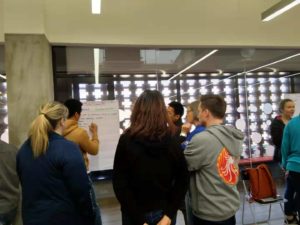 Examining the connections between culture and language
Examining the connections between culture and language- Considering the culture of collaboration in our local contexts
- Describing principles of acquisition and learning
- Examining the features of academic language
- Exploring the connections between language acquisition principles and WIDA ELD practices
- Exploring how academic language varies across subject areas and domains
- Developing differentiation for language
- Investigating the language demands of texts and tasks
- Recognizing effective feedback practices
- Providing effectivefeedback to language learners
- Discussing learning strategies
- Developing instruction andlearning strategies for ELLs
- Examining scaffolding strategies
- Identifying scaffolding strategies in practice
- Reflecting on peer observations
- Planning differentiated lessons using WIDA framework
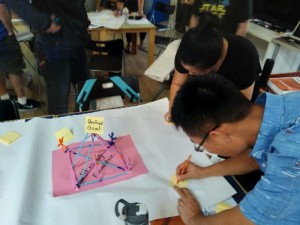
As Daystar Academy is a WIDA consortium member, I have sent several teachers to the WIDA Institute. Further, our team has been working with WIDA Can Do Descriptors and Performance Definitions for two years. We were excited to take this next step in developing our school-wide
approach to serving ELLs through collaboration and best practices.
English Language Development PROCEDURES and PROTOCOLS
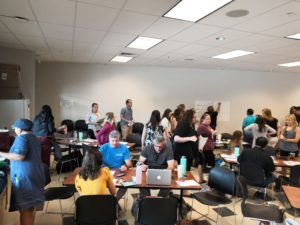 Adams 14 Culturally and Linguistically Diverse Education (CLDE) Department Procedures and Protocols
Adams 14 Culturally and Linguistically Diverse Education (CLDE) Department Procedures and Protocols
As the Culturally and Linguistically Diverse Eduction Coordinator for Adams 14, I co-designed the multilingual learner (ML) service model for our K-12 district, established ELD planning protocols, and developed and refined procedures for identifying, placing, monitoring and redesignating MLs. Below is a sample of the procedures and protocols that I co-developed:
Guidance During Remote Learning:
- Planning for Multilingual Learners During Remote Learning (content teachers)
- Guidance for Elementary Dedicated ELD Block during Remote Learning
- Guidance for Secondary Dedicated ELD Block during Remote Learning
Unit-level Planning with Considerations for Multilingual Learners:
Adams 14 has the largest percentage of language learners in the state of Colorado. In order to best support our multilingual learners, it is important to plan for their unique needs at the unit level. With this in mind our I co-developed language look-fors and support for the district-level curriculum maps. Further, our team worked with English Language Development (ELD) coaches to facilitate the development of language scope and sequence curriculum maps for our dedicated ELD teachers. Both teachers and admin alike appreciated the supports and the intenti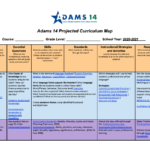 onal backwards design planning for language
onal backwards design planning for language
- Projected Curriculum Map with Embedded Language Support (template)
- Common UbD 6-12 ELA Unit Plan With Embedded Language Support (template)
- Secondary Curriculum Map with Embedded Language Support (template)
- Secondary Example (created by teachers)
- Elementary Example (created by teachers)
Backwards Planning for ELD Teachers
- Language Unit Planning Template
- Example Language Unit
- Example HS Scope and Sequence
- Example MS Scope and Sequence
- ELD Backwards Planning Support
- ELD Task Analysis- Example
- Primary Unit Level Language Planning Support
- Secondary Unit Level Language Planning Support
Examples of Model Student Responses with Sentence Frames
Learning English for Academic Proficiency (LEAP) Department Policies and Procedures
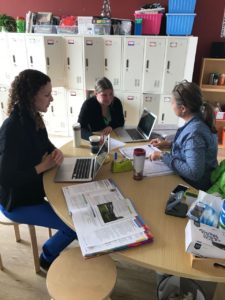 As the Language Support Services Coordinator for Daystar Academy, I designed the ELL service model for our entire K-12 private district, established and continually manage the baseline data for ELLs. Below is a sample of the policies and procedures that I developed:
As the Language Support Services Coordinator for Daystar Academy, I designed the ELL service model for our entire K-12 private district, established and continually manage the baseline data for ELLs. Below is a sample of the policies and procedures that I developed:
- English Learner Identification/Exit Criteria and Procedures
- Language Policy
- Bilingual ELL Placement Chart
- Bilingual Service Model
- IB MYP Phase Placement Procedure
- ELL Department Mission
- ELL Department Guiding principles and research
- Bilingual Notification of Service
- Bilingual Exit Letter
- Bilingual Home Language Questionnaire
Credentials
Below are links to my educational credentials.
Teaching Licenses:
- CO: Culturally and Linguistically Diverse Education (K-12) | English Language Arts (7-12)
- MN: K-12 English as a Second Language
Certifications:
- Constructing Meaning Certified Leader
- WIDA CLIMBS Trainer or Trainers
- Cambridge University Certificate of English Language Teaching to Adults (CELTA)
Education:
- Master of Arts English as a Second Language – Hamline University (TESOL Certified)
- Bachelor of Arts Liberal Arts – Colorado State University
- Associate of Applied Science Graphics and Animation Technology – Red Rocks Community College
Using Data to Inform
My experience has taught me that while teacher instinct is invaluable, it is only bolstered when pairing it with data from the individual students as it relates to program-level goals. As such, my guiding question with data is always, “How does this inform instruction?” Below are samples of using data to inform decisions at various levels:
- Looking at Data
- Program-level Data Analysis
- Informing Instruction
- Lexical Load Example
- Early Literacy Example
- Action Plan
- Action Research Example
Looking at Data
Research is clear that using a combination of formative and summative assessment data to inform instruction yields the best student results. As such, it is important to have access both kinds of data. As a small district, my current program did not have access to centralized student data. The director of Teaching Learning and Innovation and I co-created student data sheets that housed formative and summative assessment along with WIDA-inspired ELL learner profile data.
Click to see a sample of the Data Sheets
Protocol for Looking at Data
The Teaching Learning and Innovation department led a series of PDs for teachers using SRI’s ATLAS-Looking at Data or Data-Driven Dialogue Protocol. With all the data in one place and a protocol with prioritized standards to follow, teachers have been able to participate in PLCs and respond effectively to the following questions:
- What do we expect our students to learn?
- How will we know they are learning?
- How will we respond when they don’t learn?
- How will we respond if they already know it?
Program-level Data Analysis
It goes without saying that in order to communicate effectively with stakeholders and make decisions about things like staffing and service model adjustments, it’s important be able to look at program-level data and analyze below for patterns. It is only through understanding the WHAT and WHY, that we can take ownership of the HOW and make informed, impactful decisions.
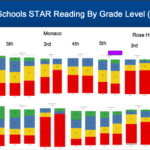 During remote learning during COVID 19, our department investigated reading data and to determine next steps in supporting our district’s 3,500 language learners. Our analysis uncovered gaps in Kindergarten instruction and also unearthed grade-level and building level instructional assets, which allowed us to both address the instructional concerns and build off the great things being done in individual classrooms. The analysis led to changes in district support that facilitated growth in ACCESS scores and an increase in student engagement measured by surveys and classroom walkthroughs.
During remote learning during COVID 19, our department investigated reading data and to determine next steps in supporting our district’s 3,500 language learners. Our analysis uncovered gaps in Kindergarten instruction and also unearthed grade-level and building level instructional assets, which allowed us to both address the instructional concerns and build off the great things being done in individual classrooms. The analysis led to changes in district support that facilitated growth in ACCESS scores and an increase in student engagement measured by surveys and classroom walkthroughs.
Reading and Math Data Multilingual Learners Mid Year 2021
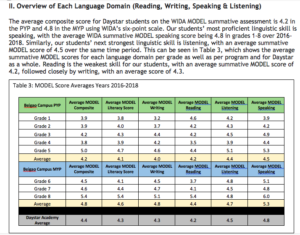
Below is a two-year analysis of Daystar Academy’s ELLs in terms of baseline proficiency, growth and exits. This analysis enabled me to shift our service model from a largely stand-alone streaming model to co-teaching and targeted pull-outs. It also allowed me to staff effectively and shift programming to more reading and writing instruction.
Daystar Academy Language Learner Summary 2016-18
Informing Instruction
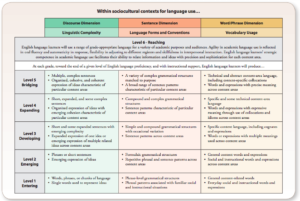 To modify my own instruction, I use formative and summative data from student data sheets, ELL learner profile data and prioritized standards and learning targets. Specially, analyze prioritized standards and content using WIDA Performance Definitions to determine linguistic complexity. I then analyze student data and WIDA level, along with WIDA Can Do Descriptors and to design WIDA MPIs and equitable and effective instruction that is a best-fit for student language proficiency.
To modify my own instruction, I use formative and summative data from student data sheets, ELL learner profile data and prioritized standards and learning targets. Specially, analyze prioritized standards and content using WIDA Performance Definitions to determine linguistic complexity. I then analyze student data and WIDA level, along with WIDA Can Do Descriptors and to design WIDA MPIs and equitable and effective instruction that is a best-fit for student language proficiency.
Lexical Load Example
In one example that comes to mind, using WIDA Performance Definitions I was able to determine that my WIDA level 2s were struggling with a lexical load that was too high for them. To remedy this, I was able to find reading material that used the same Tier 2 vocabulary as the language arts anchor text, but with a much lower lexical load. Thus, these students were exposed to grade level concepts and vocabulary that was within their Zone of Proximal Development. Students developed the same comprehension sub-skills as their peers (determining main idea and detail) using supports from the MPIs (leveled text, sentence frames, and word banks with the support of a peer). In this manner, I kept the rigor high as well as the accessibility.
View a sample of MPI strand used.
View a sample of leveled reading.
Early Literacy Example
Another example that comes to mind is an early literacy example in grades 1-3. Our students’ MAP reading scores for grades 1-3 weren’t progressing as much as we had expected after adopting a new curriculum. Digging into the MAP learning continuum data showed us a trend of a large group of students struggling at the phonics level. Responding to this, we gave this group of students individualized phonics assessments and were able to determine gaps in decoding skills. From there, we were able to dynamically group students and further target their phonics instruction to fit the needs of those gaps during our guided reading times and literacy centers. For students who still needed more help, we were able to set up short-term literacy interventions managed by ELL teachers and para-educators. This increased targeting of specific decoding skills to specific students led to much more efficient progression of decoding proficiency for our ELLs.
Action Plan
Using the PLC question format (above), educators are often are faced with determining what to do when students aren’t hitting the learning targets we are setting. When making revisions to our instruction isn’t enough, we sometimes need to do interventions or make action plans for individual students. In this example, this student was scoring far below his peers in reading, he wasn’t producing much writing and the literacy instruction in the classroom just wasn’t working. To approach this, the teacher and I assembled reading data and five writing samples. After analyzing the writing samples using the WIDA Writing Rubric, we were able determine that this student was struggling at the vocabulary level. We were also able to identify specific gaps in decoding skills. Reaching out his parents and using a combination of resources, we were able to put together an action plan that addressed vocabulary-building, specific decoding gaps, and moving from sentence-level to phrase-level writing. The plan helped this student find purchase and he made significant leaps in all three areas. We were then able to revisit the plan, make adjustments to the goals based on his work and roll out a second round. After two cycles, I’m happy to report that he is no long on an action plan!
Action Research Example
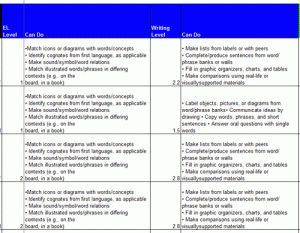 A district I worked for in the U.S. encountered a huge influx of low-level English Language Learners (ELLs), the majority of which were WIDA level 1s and 2s (newcomers). The district was at a loss as to how to proceed. Continue the current model (co-teaching and push-in)? Shift to pull-outs? How much?
A district I worked for in the U.S. encountered a huge influx of low-level English Language Learners (ELLs), the majority of which were WIDA level 1s and 2s (newcomers). The district was at a loss as to how to proceed. Continue the current model (co-teaching and push-in)? Shift to pull-outs? How much?
As there is not a lot of research regarding newcomers or SLIFE and service models, I performed an 8-week action research study comparing two service models: co-teaching and push-in; targeted pull-out with push-in support. I was able to determine that targeted pull-out with a sheltered instruction model was a better fit for these students as they made larger strides in decoding, comprehension and writing development. As a result, we were able to shift to this model until the students were able to pass beginning of the year benchmarks. At that point, we were able to shift back to co-teaching and a push-in more effectively.
- A summary of the study can be found here.
- The summative data can be found here.
- The full data set can be found here.
Master’s Thesis
I invite you to read my master’s thesis on SLIFE writing, which has been downloaded and read over 300 times all over the world.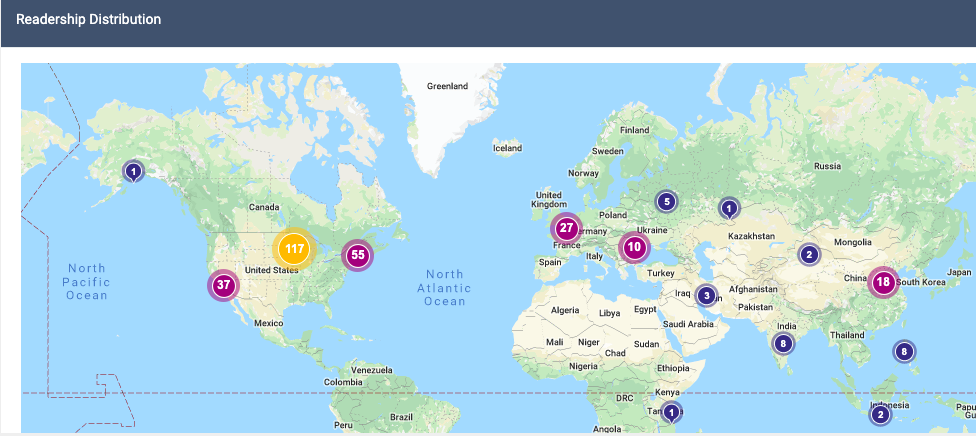
Abstract
Fossenbell, B. Visual Support in Discourse Writing for Students With Limited or Interrupted Formal Education (2016)
The research question addressed in this project was: for Students with Limited or Interrupted Formal Education (SLIFE), how can a series of integrated graphic organizers, implemented in an environment informed by the Mutually Adaptive Learning Paradigm (MALP), improve students’ use of result and exemplification discourse connectors in developing written arguments? The motivating factor for this capstone was the researcher’s observations of the struggles SLIFE encounter in moving from sentence-level to discourse-level writing proficiency. The action research integrated qualities of MALP, based on the work of DeCapua and Marshall, with an interrelated series of graphic organizers, influenced by Gibbons, in an attempt to help SLIFE improve their use of result and exemplification discourse connectors in argument essays. The study found that the combination helped students organize their thoughts, align their reasons and examples, and increase their use of the target language.
Student Work Samples
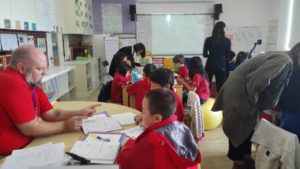 At the end of the day, our work as educators is to advance student success. I invite you to view a sampling of student work supported by tools and strategies implemented by myself or my ELL team.
At the end of the day, our work as educators is to advance student success. I invite you to view a sampling of student work supported by tools and strategies implemented by myself or my ELL team.
Middle School
| WIDA Level 1 | |
| Over the years, I have worked with many Students with Limited or Interrupted Formal Education (SLIFE). When I met this particular student, he had only received a year of formal instruction as a twelve year-old. This is a sample of his writing in the beginning of the year. | 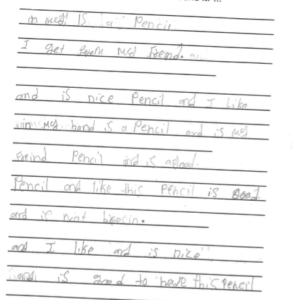 |
| Through creating class-constucted models, the use of sentence frames and feedback, this student’s work started to blossom even though his lexicon was still quite low. This a sample of his writing mid-year. | 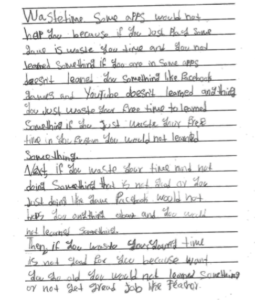 |
| WIDA level 2 | |
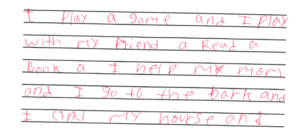 |
|
|
|
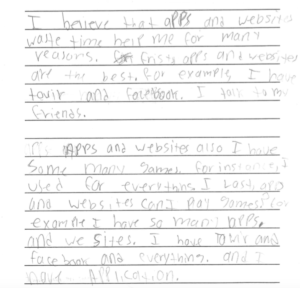 |
| WIDA level 3 | |
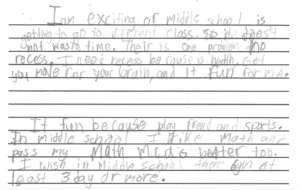 |
|
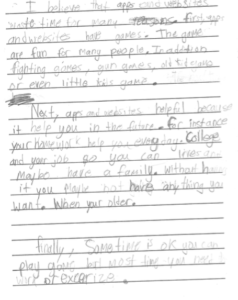 |
Elementary School
| WIDA level 1 | |
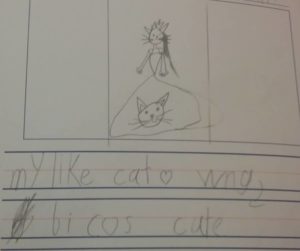 |
|
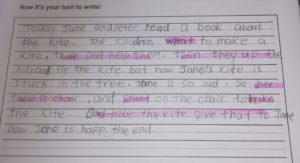 |
| WIDA level 2 | |
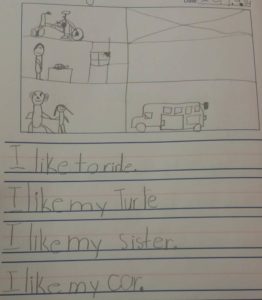 |
|
 |
| WIDA level 3 | |
 |
|
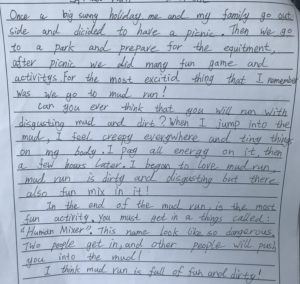 |
Language Supports and Differentiated Materials
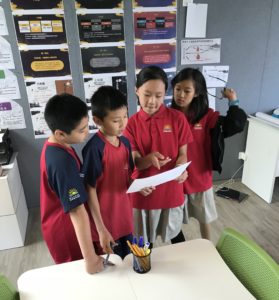
I invite you to peruse some of the instructional supports I use, adaptations I have made as well as work my students have produced.
- Vocabulary
- Speaking to Writing Connection
- Writing
- Assessment Differentiation – Keeping the Rigor
- Culturally Responsive Adaptation
Vocabulary
I use the Frayer Model 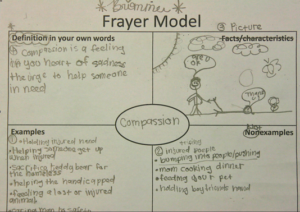 and also adaptations of Marzano’s 6 Steps. Using strategies like these, alongside Beck’s Model and multiple meaning-rich interactions, I’ve seen students’ academic lexicon explode.
and also adaptations of Marzano’s 6 Steps. Using strategies like these, alongside Beck’s Model and multiple meaning-rich interactions, I’ve seen students’ academic lexicon explode.
I believe in using concrete images whenever possible and pairing them with student-friendly definitions and student drawings.
Together, I’ve found this can help students connect to vocabulary more quickly and thus retain it longer.
View a sample of Vocabulary Powerpoint.
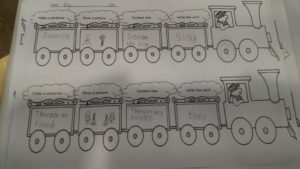 |
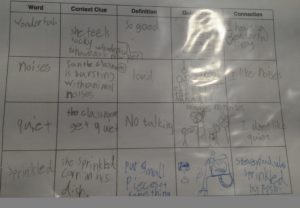 |
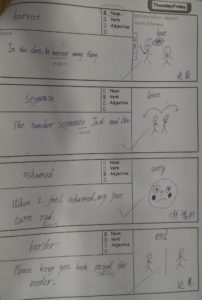 |
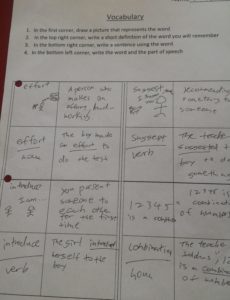 |
Speaking to Writing Connection
R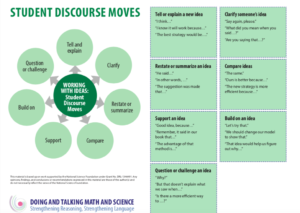 esearch tells us that ELLs benefit from making connections from speaking to writing when grappling with academic content. In my experience, most learners benefit from clarifying and developing understanding of complex concepts verbally. Two of the best tools I’ve found to address this Jeff Zwiers’ Academic Conversation Placemat with Prompts and the National Science Foundation’s Discourse Moves (http://stem4els.wceruw.org/).
esearch tells us that ELLs benefit from making connections from speaking to writing when grappling with academic content. In my experience, most learners benefit from clarifying and developing understanding of complex concepts verbally. Two of the best tools I’ve found to address this Jeff Zwiers’ Academic Conversation Placemat with Prompts and the National Science Foundation’s Discourse Moves (http://stem4els.wceruw.org/).
While these take some modeling, norming and feedback, and certainly need some adjustments for younger learners and entering/emerging language learners, I’ve found the process to be invaluable in providing learners the structures and conventions for deepening thinking. Higher level discussions, even with limited vocabulary, are fun for learners and definitely lay the ground work for better writing.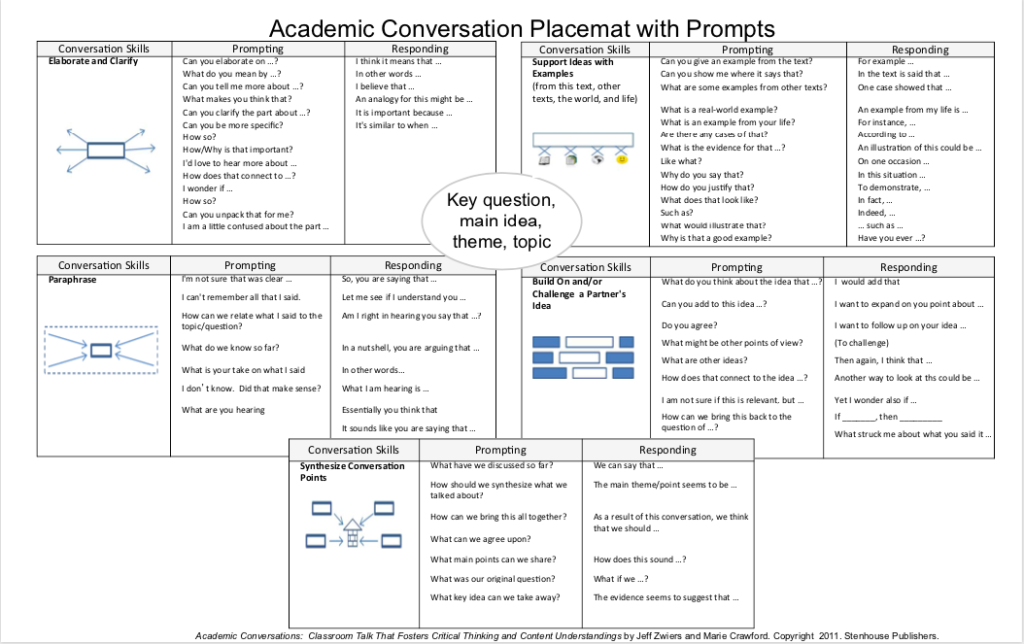
Writing Scaffolds
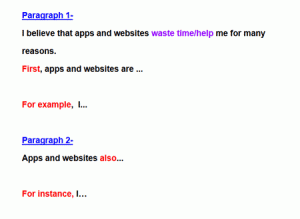 I’ve found the combination of the following to be game-changers for my students:
I’ve found the combination of the following to be game-changers for my students:
- Analyzing Models
- Using background knowledge to generate vocabulary and ideas
- Sentence Frames and Word Banks
- Peer Feedback
At first, student use of sentence frames may sound formulaic, but over time students start to make the forms their own as they build vocabulary, analyze models further and make adjustments from targeted feedback.
See samples below of student work using these four strategies:
- WIDA level 2 — Student with Interrupted or Formal Education (SLIFE)
- WIDA level 3 — Student with Interrupted or Formal Education (SLIFE)
Writing Scaffold Sample
After reviewing our standarized reading data along WIDA writing assessment data, we as a school determined that we had some issues with writing related to stamina. As one of many initiatives to address this, our school rolled out a mandatory writing period; where for 20 minutes each day, everyone the school would write. A sample writing prompt for elementary can be found here.
While this was a great step for our school, it was a shock to the system for our WIDA level 2s and 3s. Imagine trying to write in a non-native language for 20 minutes a day as an emergent language learner!
The challenge then was to devise a scaffold that could be used with the prompt for WIDA 2-3. This is a sample of the scaffold for the sample writing prompt. The full set can be viewed here.
The response was overwhelming. Students went from being frustrated and producing nothing, to filling multiple pages in a matter of weeks.
Assessment Differentiation – Keeping the Rigor
As a part of our unit on non-fiction, our 2nd grade team designed a reading test to assess the following standards:
- RI2.8: Describe how reasons support specific points the author makes in a text.
- RI2.9: Compare and contrast the most important points presented by two texts on the same topic.
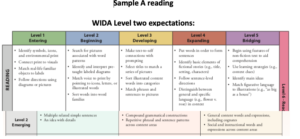
The grade had several WIDA level twos who were reading in the A range on F+P running records and BR range on MAP. As a team, we were concerned that the assessment was not accessible to our WIDA level 2s and that the assessment would not return useable data regarding students’ true ability to demonstrate their knowledge as it relates to these standards.
After deconstructing the standards into component parts, we were able to adapt the assessment text to fit the criteria for emerging readers using the WIDA Performance Definitions. Once we had accessible reading material that fit the standards being measured, we were then able to use the Can Do Descriptors and List of Supports to design supports for the assessment.
The results were amazing! Teachers learned that students had a much higher proficiency with the skills of identifying key point and details and comparing and contrasting than they had anticipated. This in turn helped them to design their next unit to build off of this proficiency and extend it. From the student point of view, our WIDA 2s were able to demonstrate their knowledge, lower their affective filter, and build confidence as readers.
Culturally Responsive Teaching
When teaching my new-to-country SLIFE students family vocabulary, I found that the Western-centric imagery and material for teaching family structure was not working for my students. Part of this, is that the material in a lot of ESL texts is not representative of the cultures many students come from.
To counter this, I created some material using actual photos of Somali families as well as some graphic organizers that reflected their family structure as well as using names that were more representative of their background. The result was telling. Students picked up the vocabulary faster and used it more effectively.





